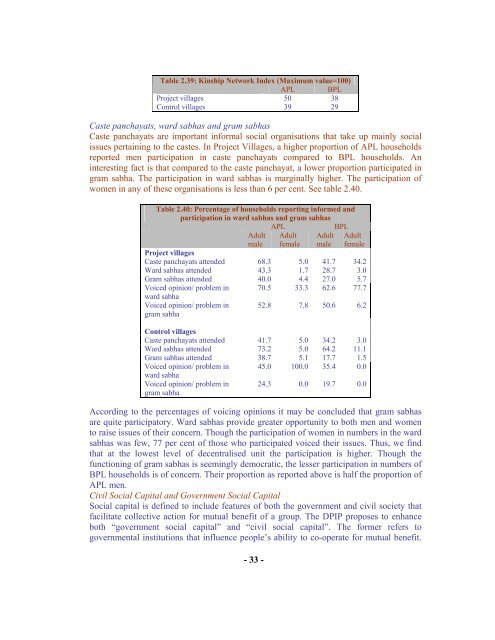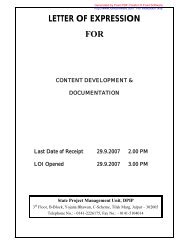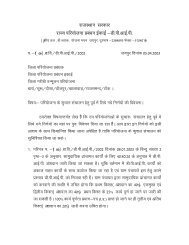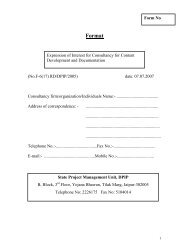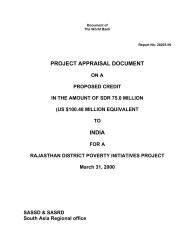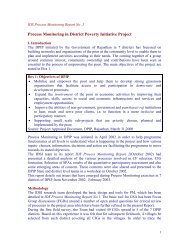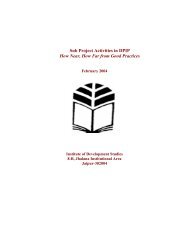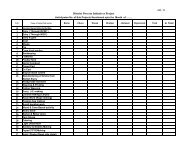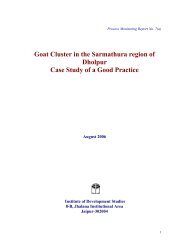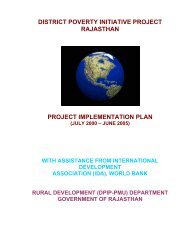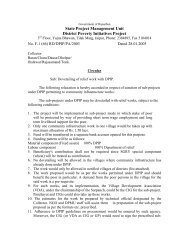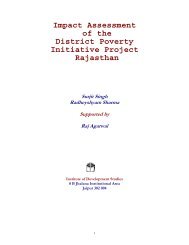Download PDF - Rajasthan Rural Livelihoods Project
Download PDF - Rajasthan Rural Livelihoods Project
Download PDF - Rajasthan Rural Livelihoods Project
Create successful ePaper yourself
Turn your PDF publications into a flip-book with our unique Google optimized e-Paper software.
Table 2.39: Kinship Network Index (Maximum value=100)APL BPL<strong>Project</strong> villages 50 38Control villages 39 29Caste panchayats, ward sabhas and gram sabhasCaste panchayats are important informal social organisations that take up mainly socialissues pertaining to the castes. In <strong>Project</strong> Villages, a higher proportion of APL householdsreported men participation in caste panchayats compared to BPL households. Aninteresting fact is that compared to the caste panchayat, a lower proportion participated ingram sabha. The participation in ward sabhas is marginally higher. The participation ofwomen in any of these organisations is less than 6 per cent. See table 2.40.Table 2.40: Percentage of households reporting informed andparticipation in ward sabhas and gram sabhasAPLBPLAdultmaleAdultfemaleAdultmale- 33 -Adultfemale<strong>Project</strong> villagesCaste panchayats attended 68.3 5.0 41.7 34.2Ward sabhas attended 43.3 1.7 28.7 3.0Gram sabhas attended 40.0 4.4 27.0 5.7Voiced opinion/ problem inward sabhaVoiced opinion/ problem ingram sabha70.5 33.3 62.6 77.752.8 7.8 50.6 6.2Control villagesCaste panchayats attended 41.7 5.0 34.2 3.0Ward sabhas attended 73.2 5.0 64.2 11.1Gram sabhas attended 38.7 5.1 17.7 1.5Voiced opinion/ problem in 45.0 100.0 35.4 0.0ward sabhaVoiced opinion/ problem ingram sabha24.3 0.0 19.7 0.0According to the percentages of voicing opinions it may be concluded that gram sabhasare quite participatory. Ward sabhas provide greater opportunity to both men and womento raise issues of their concern. Though the participation of women in numbers in the wardsabhas was few, 77 per cent of those who participated voiced their issues. Thus, we findthat at the lowest level of decentralised unit the participation is higher. Though thefunctioning of gram sabhas is seemingly democratic, the lesser participation in numbers ofBPL households is of concern. Their proportion as reported above is half the proportion ofAPL men.Civil Social Capital and Government Social CapitalSocial capital is defined to include features of both the government and civil society thatfacilitate collective action for mutual benefit of a group. The DPIP proposes to enhanceboth “government social capital” and “civil social capital”. The former refers togovernmental institutions that influence people’s ability to co-operate for mutual benefit.


